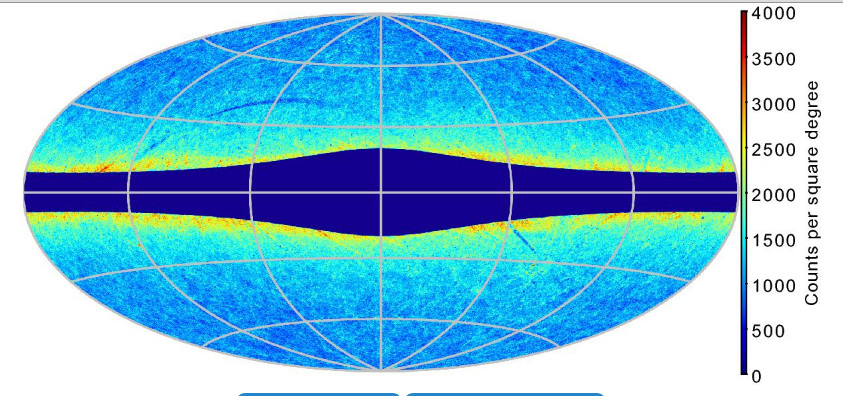Astronomy Object of the Month: 2019, February
< previous Archive next >
Stars, galaxies and quasars from the Infrared WISE Survey
The Wide-field Infrared Survey Explorer (WISE)
satellite has detected hundreds of millions of new infrared sources. Classifying them reliably is, however,
a very challenging task. Simple colour cuts are often not sufficient; for satisfactory levels of completeness and purity,
more sophisticated classification methods are needed. A team of astronomers from Jagiellonian University and other Polish
research centers is developing new, automated methods of source classification in full-sky WISE data.

Illustration 1: All-sky map of 45
million galaxy candidates identified in AllWISE W1 band (below 16 mag) data, in
Aitoff projection in Galactic coordinates.
Credit: the Authors.
The Wide-field Infrared Survey Explorer is a space-borne telescope that has scanned the entire sky in four infrared bands in the range of 3.4 to 22 μm. It has detected almost 750 million sources, which are compiled in the publicly released AllWISE Source Catalogue. WISE provides at present the most comprehensive census of the entire sky in the IR, and offers large advancement in comparison to earlier all-sky IR surveys, such as IRAS (1984), 2MASS (2006), or AKARI (2007).
The main goal of the Polish team was to obtain comprehensive and reliable star, galaxy, and quasar catalogues in which the used classification will employ only the parameters available from WISE itself - those which are reliably measured for the majority of sources. The automatic classification is based on supervised machine learning algorithms. It requires a training sample of celestial objects with relevant classes already identified - here the SDSS spectroscopic dataset (DR10) has been used for that purpose. The obtained classification accuracy have been tested as a function of extinction and apparent magnitude, minimum number of sources in the training set required to achieve stable classification, and the minimum dimension of the parameter space. It was estimated that a training sample of less than 10 000 randomly chosen sources was sufficient to obtain stable results. Finally, the method was applied to all-sky WISE data, flux-limited to 16 mag in the 3.4 μm channel.
The team obtained very good classification efficiency in all the tests. At the bright end, the completeness for stars and galaxies reaches ~95%, deteriorating to ~80% at the limit of 16 mag, while for quasars it stays at a level of ~95% independently of magnitude. Applying the new method to full-sky WISE data resulted in completing the reliable catalogues of star, galaxy and quasar candidates. However, the sources flagged by the "classifier" (classifying algorithm) as “quasars” are in fact dominated by dusty galaxies. They also exhibit contamination from sources located mainly at low ecliptic latitudes.
The catalogue of candidate galaxies - unlike stars - needed additional corrections. The team cut out the most confused areas of the Galactic Plane and Milky Way's Bulge, removing almost 30 million objects out of the 84.5 million pre-assigned to the galaxy class in the all-sky. Additionally, they eliminated the brightest sources and four hundreds of "outliers" at the faint end of the examined band (> 16.1 mag). This automatically removed sources which are most certainly stellar.
The quasar candidates sample underwent similar purification. The same cutout of the Galactic plane was first applied, which removed almost 30% of the over 9 million all-sky sources previously recognized as quasars. Then, the team used the bright-end cuts to eliminate the objects that were mostly misclassified stars or blends of stars, localised mainly at low Galactic latitudes and in the Magellanic Clouds. It was also noted that there is a lack of sources at low Galactic latitudes, qualitatively similar to the WISE AGN distribution previously presented in Ferraro et al. (2015) sample, where sources were classified based on colour cuts. In addition, it was discovered that various WISE scanning issues are imprinted in the obtained results, including the overdensity stripes perpendicular to the ecliptic, resulting from Moon avoidance manoeuvres of the WISE satellite. There is additional spurious overdensity which seems to roughly follow the ecliptic, visible at the top right of the map and below the Bulge, to the left. This suggests some very local contamination, such as from asteroids or maybe zodiacal light, and most likely reflects the presence of a fourth type of sources in addition to the three types present in the training set from the SDSS.
Original publication: Towards automatic classification of all WISE sources (A. Kurcz, M. Bilicki, A. Solarz, M. Krupa, A. Pollo, K. Małek, Astronomy and Astrophysics).
The research was conducted at the Department of Stellar and Extragalactic Astronomy of the Jagiellonian University’s Astronomical Observatory (OAUJ). The work was supported by the Polish National Science Centre through the grant UMO-2012/07/D/ST9/02785.
|
Agnieszka Kurcz Astronomical Observatory Jagiellonian University A.Kurcz [at] uj.edu.pl |
Magdalena Krupa Astronomical Observatory Jagiellonian University M.Krupa [at] oa.uj.edu.pl |
Agnieszka Pollo Astronomical Observatory Jagiellonian University A.Pollo [at] oa.uj.edu.pl |


